1995 BUICK REGAL warning light
[x] Cancel search: warning lightPage 155 of 340
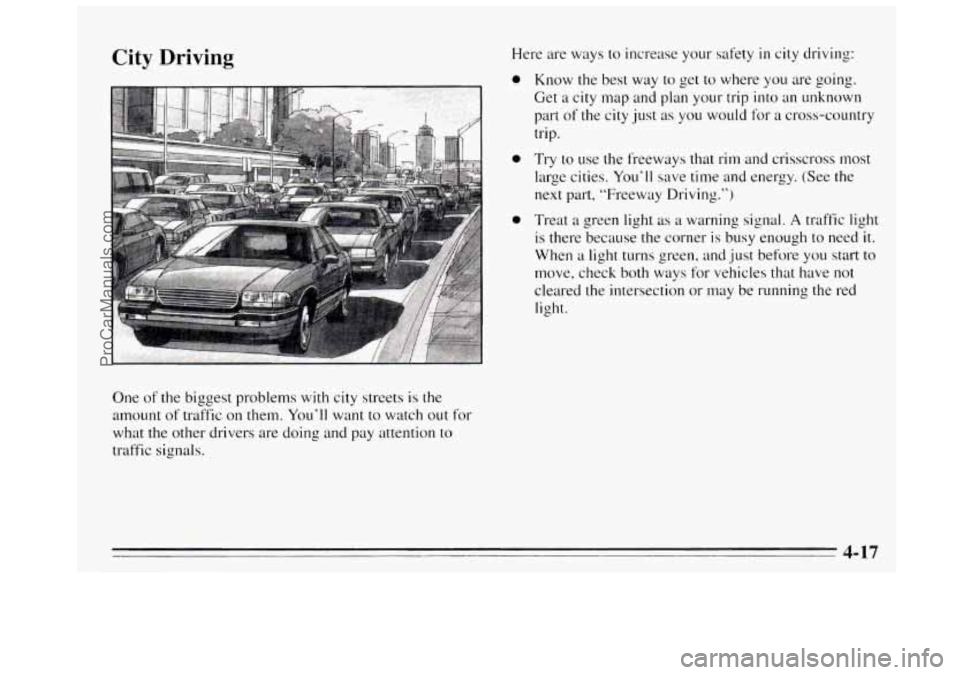
City Driving
One of the biggest problems with city streets is the
amount
of traffic on them. You’ll want to watch out for
what the other drivers are doing and pay attention to
traffic signals. Here are ways to increase
your safety
in city driving:
0
0
0
Know the best way to get to where you are going.
Get
a city map and plan your trip into an unknown
part
of the city just as you would for a cross-country
trip.
Try to use the freeways that rim and crisscross most
large cities.
You’ll save time and energy. (See the
next part, “Freeway Driving.”)
Treat
a green light as a warning signal. A traffic light
is there because the corner is busy enough to need it.
When a light turns green, and just before you start to
move, check both ways for vehicles that have not
cleared the intersection or may be running the red
light.
4-17
ProCarManuals.com
Page 160 of 340
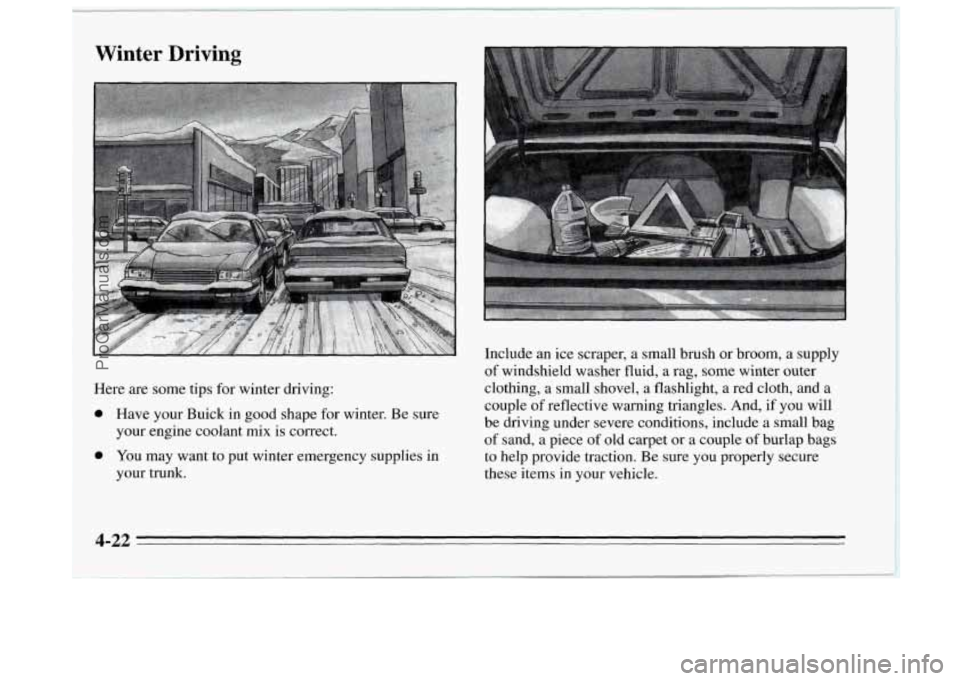
Winter Driving
Here are some tips for winter driving:
0 Have your Buick in good shape for winter. Be sure
0 You may want to put winter emergency supplies in
your
engine coolant
mix is correct.
your trunk. Include
an ice scraper, a small brush or broom,
a supply
of windshield washer fluid, a rag, some winter outer
clothing, a small shovel, a flashlight, a red cloth,
and a
couple of reflective warning triangles. And, if you will
be driving under severe conditions, include a small bag
of sand, a piece of old carpet
or a couple of burlap bags
to help provide traction. Be sure you properly secure
these items in your vehicle.
4-22
ProCarManuals.com
Page 188 of 340
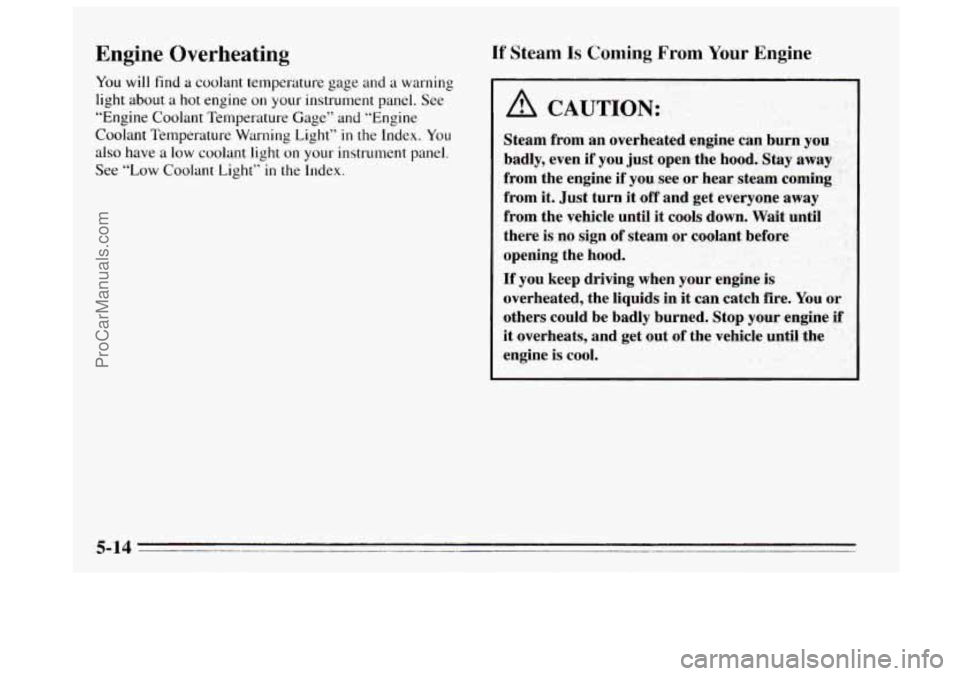
Engine Overheating
You will find a coolant temperature gage and a warning
light about
a hot engine on your instrument panel. See
“Engine Coolant Temperature Gage” and “Engine
Coolant Temperature Warning Light”
in the Index. You
also have a low coolant light on your instwrnent panel.
See “Low Coolant Light”
in the Ilrdex.
If Steam Is Coming From Your Engine
A CAUTION:
Steam from an overheated engine can burn you
badly, even if you just open the hood. Stay away
from the engine
if you see or hear steam corning
from it. Just turn
it off and get everyone away
from the vehicle until it cools down. Wait until
there is no sign of steam
or coolant before
opening the hood.
If you keep driving when your engine is
overheated, the liquids in it can catch fire. You or
others could be badly burned. Stop your engine
if
it overheats, and get out of the vehicle until the
engine is cool.
ProCarManuals.com
Page 225 of 340

How to Add Fluid
Refer to the Maintenance Schedule to determine what
kind of transaxle fluid to use. See “Recommended
Fluids and Lubricants”
in the Index.
If the fluid level is low, add only enough of the proper
fluid to bring the level into the cross-hatched area on the
dipstick.
1. Pull out the dipstick.
2. Using a long-neck funnel, add enough fluid at the
dipstick hole
to bring it to the proper level.
It doesn’t take much fluid, generally less than a pint
(OSL). Don ’t ouefill. We recommend you use only fluid
labeled DEXRON@-111, because fluid with that label is
made especially for your automatic transaxle. Damage
caused by fluid other than DEXRON@-I11 is not covered
by your new vehicle warranty.
After adding fluid, recheck the fluid level as
described under “How
to Check.”
When the correct fluid level is obtained, push the
dipstick back in all the way.
Engine Coolant
The following explains your cooling system and how to
add coolant when it is low. If you have a problem with
engine overheating or if
you need to add coolant to your
radiator, see “Engine Overheating” in the Index.
The proper coolant for your Buick will:
Give freezing protection down to -34°F (-37°C).
Give boiling protection up to 262 OF (1 28 O C).
Protect against rust and corrosion.
Help keep the proper engine temperature.
Let the warning lights work as they should.
What to Use
Use a mixture of one-half clean water (preferably
distilled) and one-half antifreeze that meets “GM
Specification
1825-M,” which won’t damage aluminum
parts. You can also use a recycled coolant conforming to
GM Specification 1825-M with a complete coolant flush
and refill. Use GM Engine Coolant Supplement (sealer)
with any complete coolant flush and refill.
If you use
this mixture, you don’t need to add anything else.
~
6-17
ProCarManuals.com
Page 232 of 340

should have your brake system fixed, since a leak means
that sooner or later your brakes won’t work well, or
won’t work at all.
So, it isn’t a good idea to “top off’
your brake fluid. Adding brake fluid won’t correct a
leak. If you add fluid when your linings are worn, then
you’ll have too much fluid when you get new brake
linings. You should add (or remove) brake fluid, as
necessary, only when work is done on the brake
hydraulic system.
When your brake fluid falls to a low level, your brake
warning light will come on. See “Brake System Warning
Light” in the Index. What to Add
When you do need brake fluid, use only DOT-3 brake
fluid -- such as Delco Supreme ll@ (GM Part No.
1052535). Use new brake fluid from a sealed container
only, and always clean the brake fluid reservoir cap
before removing it.
NOTICE:
0
0
Don’t let someone put in the wrong kind of
fluid. For example, just
a few drops of
mineral-based oil, such
as engine oil, in
your brake system can damage brake system parts
so badly that they’ll have to be
replaced.
Brake fluid can damage paint,
so be careful
not to spill brake fluid on your vehicle.
If
you do, wash it off immediately. See
“Appearance Care’’ in the Index.
6-24
ProCarManuals.com
Page 233 of 340
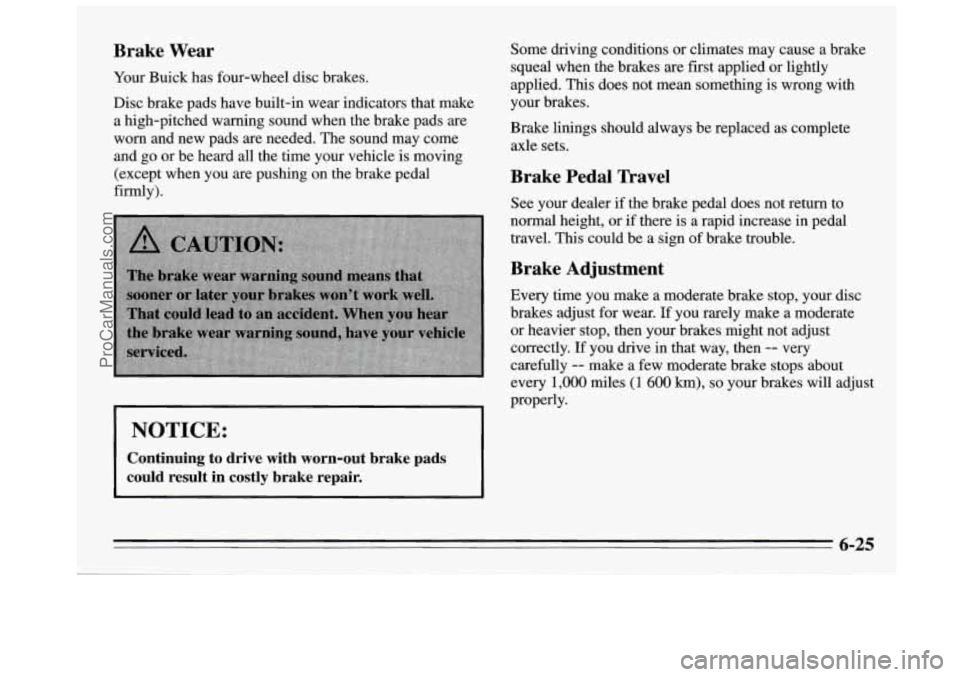
Brake Wear
Your Buick has four-wheel disc brakes.
Disc brake pads have built-in wear indicators that make
a high-pitched warning sound when the brake pads are
worn and new pads are needed. The sound may come
and go or be heard all the time your vehicle is moving
(except when you are pushing
on the brake pedal
firmly),
NOTICE:
Continuing to drive with worn-out brake pads
could result in costly brake repair.
Some driving conditions or climates may cause a brake
squeal when the brakes are first applied or lightly
applied.
This does not mean something is wrong with
your brakes.
Brake linings should always be replaced as complete
axle sets.
Brake Pedal Travel
See your dealer if the brake pedal does not return to
normal height, or
if there is a rapid increase in pedal
travel. This could be a sign of brake trouble.
Brake Adjustment
Every time you make a moderate brake stop, your disc
brakes adjust for wear.
If you rarely make a moderate
or heavier stop, then your brakes might not adjust
correctly.
If you drive in that way, then -- very
carefully
-- make a few moderate brake stops about
every
1,000 miles (1 600 km), so your brakes will adjust
properly.
6-25
ProCarManuals.com
Page 328 of 340
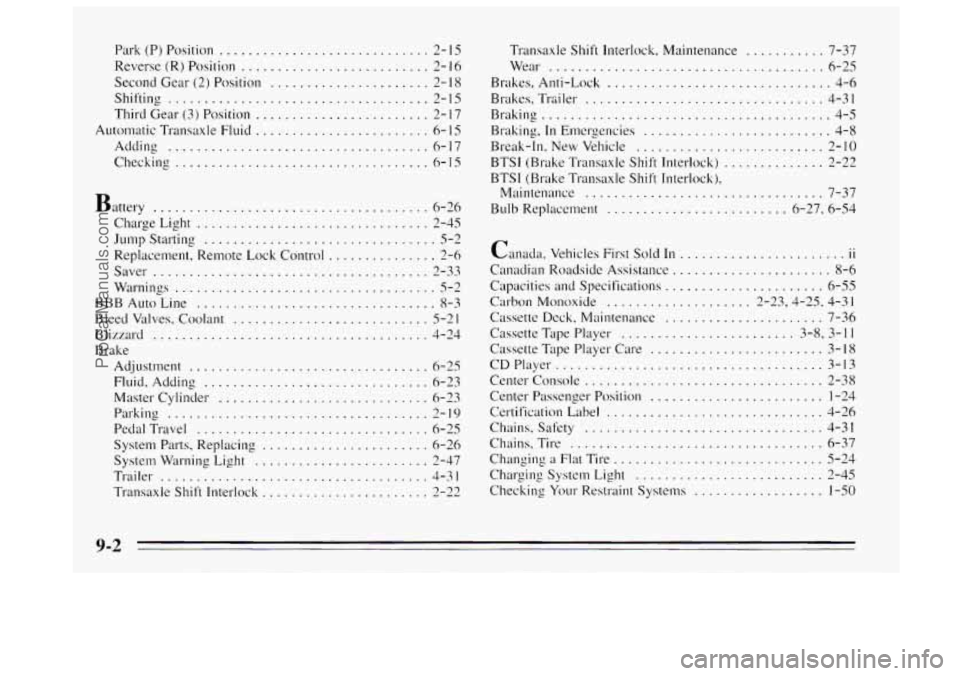
Park (P) Position ............................. 2- I5
Second Gear (2) Position
...................... 2- 18
Reverse (R) Position .......................... 2- I6
Shifting .................................... 2-15
Third Gear (3) Position
........................ 2- I7
Automatic Transaxle Fluid ........................ 6- 15
Adding
.................................... 6-17
Checking
................................... 6- 15
Battery ...................................... 6-26
Cllarpe Light
................................ 2-45
Jump Starting
................................ 5-2
Replacement. Remote Lock Control
............... 2-6
Saver
...................................... 2- 33
Warnings .................................... 5-2
BBB Auto Line ................................. 8-3
Bleed Valves. Coolant
........................... 5-21
Blizzard ...................................... 4-24
Brake
Adjustment
................................. 6-25
Fluid. Adding
............................... 6-23
Master Cylinder
............................. 6-23
Parking
.................................... 2-19
PedalTravel ................................ 6-25
System Parts. Replacing ....................... 6-26
System Warning Light
........................ 2-47
Trailer
..................................... 4- 31
Transaxle Shift Interlock ....................... 2-22 Transaxle Shift Interlock
. Maintenance ........... 7-37
Wear
...................................... 6-25
Brakes. Anti-Lock
............................... 4-6
Brakes. Trailer .................................
Braking . In Emcrgencies .......................... 4-8
Break-In. New Vehicle .......................... 2-10
BTSI (Brake Transaxle Shift Interlock)
.............. 2-22
Maintenance
................................. 7-37
Bulb Replacen~ent ......................... 6-27. 6-54
Braking
........................................ 4-5
BTSI
(Brake Transaxle Shift Interlock).
Canada. Vehicles First Sold In 11
Canadian Roadside Assistance ...................... 8-6
Capacities and Specit'ications
...................... 6-55
Carbon Monoxide
.................... 2-23. 4-25. 4-31
Cassette Dcck. Maintenance ...................... 7-36
Cassette
Tape Player ........................ 3-8. 3-11
Casselte Tape Player Care
........................ 3-18
CDPlaye r
..................................... 3-13
Center Console
................................. 2-38
Center Passenger Position
........................ 1-24
Certification Label .............................. 4-26
Chains. Safety
................................. 4-31
Chains. Tire
................................... 6-37
Changing
a Flat Tire ............................. 5-24
Charging System Light
.......................... 2-45
Checking Your Restraint Systems .................. 1-50
.. .......................
9-2
ProCarManuals.com
Page 331 of 340

Engine Coolant ................................. 6- 17
Adding
.................................... 6-18
Checking ................................... 6-18
Heater
................................ 2- 14. 6. I3
Temperature Gage
............................ 2-50
Temperature Light
........................... 2-49
Engineoil
..................................... 6-7
Additives
................................... 6-12
Checking
.................................... 6-8
What Kind to Use ............................ 6- IO
What to Do with Used Oil ..................... 6-13
When to Change
............................. 6- 12
Ethanol
(In Fuel) ................................ 6-3
Exhaust. Engine
................................ 2-23
Expectant Mothers. Use
of Safety Belts ............. 1-24
Extender. Safety Belt
............................ 1-50
Adding
..................................... 6-9
Fabric Cleaning
............................... 6-39
Fiberglass Springs
.............................. 6-44
Filling Your Tank ................................ 6-5
Filter
. Air Cleaner .............................. 6- 13
Finish Care .................................... 6-42
Finish Damage
................................. 6-43
First Gear. Automatic Transaxle
................... I 3-18
Fixed Mast Antenna ............................. 3- 19 Flashers
. Hazard Warning ......................... 5- I
Flat
Tire. Changing ............................. 5-24
Fluid Capacities
................................ 6-55
Fluid Levels. Maintenance
........................ 7-36
Fluids and Lubricants
............................ 7-40
Foreign Countries
. Fuel ........................... 6-4
Four-Way Manual Seat
........................... 1-2
Freeway Driving
............................... 4-18
French Language Manual
11
Fr011t Seatback Latches ........................... 1-5
Fuel .......................................... 6-3
Filling Your Tank
............................. 6-5
Gage
...................................... 2-44
In Foreign Countries
........................... 6-4
LowLight
.................................. 2-45
Fuse Block. Instrument Panel
..................... 6-48
Fuses and Circuit Breakers
....................... 6-47
.. ...........................
Gage . En. trine Coolant Temperature ............... 2-50
Gasoline
....................................... 6-3
Gasolines for Cleaner Air
......................... 6-4
GAWR
(Gross Axle Weight Rating) ................ 4-26
Gear Positions
................................. 2- IS
Glass. Cleaning ................................ 6-41
GloveBox ..................................... 2-8
GVWR (Gross Vehicle Weight Rating)
.............. 3-26
9-5
ProCarManuals.com